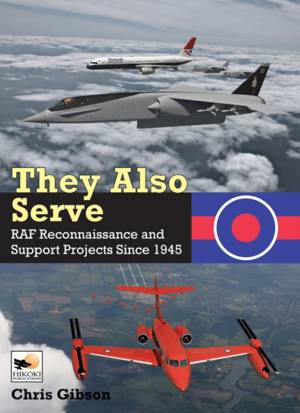
- Retrait gratuit dans votre magasin Club
- 7.000.000 titres dans notre catalogue
- Payer en toute sécurité
- Toujours un magasin près de chez vous
- Retrait gratuit dans votre magasin Club
- 7.000.0000 titres dans notre catalogue
- Payer en toute sécurité
- Toujours un magasin près de chez vous
They Also Serve
RAF Reconnaissance and Support Projects Since 1945
Chris Gibson
Livre relié | Anglais
48,95 €
+ 97 points
Description
"This book is a good mix of the technical details of the airframes, interspersed with details of what they were accomplishing through the particular machines, science, and examples. This book will appeal to both readers interested in airframes, missions, and the creativity used to create indispensable technologies." -IPMS/USA
This book is a history of RAF support units since 1945. These elements undertook a wide range of vital duties including providing intelligence in the form of radar and photographic reconnaissance, early warning and air defence, casualty evacuation, air-to-air refuelling and even VIP transportation; the aircraft of both the King's or Queen's Flight and those used to ferry the Top Brass around the theatre and battlefields.
The aircraft used in these roles since World War Two were as varied as the roles themselves. Radar and photographic reconnaissance involved English Electric Canberras, Handley Page Victors and ultimately the Sentinel R1. Tactical reconnaissance missions used the Gloster Meteor, Supermarine Swift and Hawker Hunter followed by the SEPECAT Jaguar and Panavia Tornado of the late and post-Cold War eras.
In the air defence field, Avro Shackleton AEW.2 and BAe Nimrod AEW3 were developed to provide airborne early warning, a role that was eventually passing to the Boeing E-3D Sentry AEW.1. Air-to-air refuelling, in which the British led the field in 1945 but then abandoned, was revived in the late 1950s when surplus Vickers Valiants and Handley Page Victor were converted to tankers. Since 1982, tankers have become invaluable to the RAF; among the aircraft used were the VC10, Hercules and Vulcan and the Airbus Voyager.
This detailed and meticulously researched book shows how support types became increasingly important as the Cold War evolved. Using recently declassified information, it examines design studies and prototypes that led to the development of the systems that allowed the sharp end of the RAF to operate in the Cold war and in the wars of the decades that followed.
This book is a history of RAF support units since 1945. These elements undertook a wide range of vital duties including providing intelligence in the form of radar and photographic reconnaissance, early warning and air defence, casualty evacuation, air-to-air refuelling and even VIP transportation; the aircraft of both the King's or Queen's Flight and those used to ferry the Top Brass around the theatre and battlefields.
The aircraft used in these roles since World War Two were as varied as the roles themselves. Radar and photographic reconnaissance involved English Electric Canberras, Handley Page Victors and ultimately the Sentinel R1. Tactical reconnaissance missions used the Gloster Meteor, Supermarine Swift and Hawker Hunter followed by the SEPECAT Jaguar and Panavia Tornado of the late and post-Cold War eras.
In the air defence field, Avro Shackleton AEW.2 and BAe Nimrod AEW3 were developed to provide airborne early warning, a role that was eventually passing to the Boeing E-3D Sentry AEW.1. Air-to-air refuelling, in which the British led the field in 1945 but then abandoned, was revived in the late 1950s when surplus Vickers Valiants and Handley Page Victor were converted to tankers. Since 1982, tankers have become invaluable to the RAF; among the aircraft used were the VC10, Hercules and Vulcan and the Airbus Voyager.
This detailed and meticulously researched book shows how support types became increasingly important as the Cold War evolved. Using recently declassified information, it examines design studies and prototypes that led to the development of the systems that allowed the sharp end of the RAF to operate in the Cold war and in the wars of the decades that followed.
Spécifications
Parties prenantes
- Auteur(s) :
- Editeur:
Contenu
- Nombre de pages :
- 336
- Langue:
- Anglais
Caractéristiques
- EAN:
- 9781800353084
- Date de parution :
- 28-08-24
- Format:
- Livre relié
- Format numérique:
- Genaaid
- Dimensions :
- 210 mm x 297 mm
- Poids :
- 1678 g

Les avis
Nous publions uniquement les avis qui respectent les conditions requises. Consultez nos conditions pour les avis.






